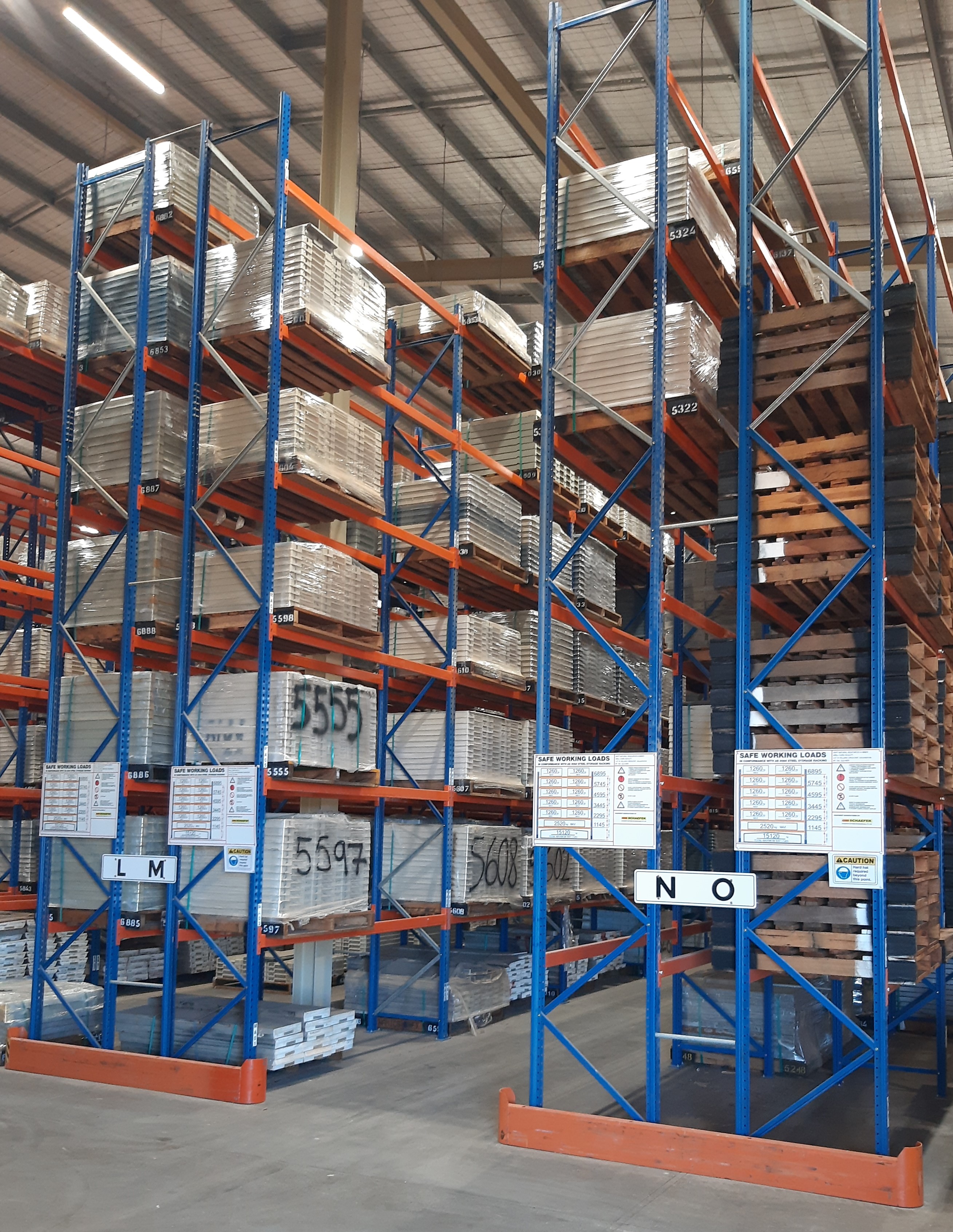Title Page
-
Standards Audit - Racking
-
Conducted on
-
Prepared by
-
Location
-
Personnel involved
Procurement of racking systems and components
-
Procurement of racking systems and components
All racking systems and components shall be procured in accordance with the following requirements:
a) They are purchased from a recognised, reputable supplier;
b) A legal contract has been used which must include specific compliance requirements as part of the specifications;
c) All racking is to be certified prior to procurement and this requirement is included in the contract specifications; and
d) Where used racking is procured, the condition has been inspected and certified as safe to use by a competent person.
Note: It is not recommended that used racking systems and components be procured from external to the site. However, it is recognised that racking materials may be transferred between sites which have excess stocks. -
Enter your findings, evidence reviewed and recommendations below
-
Select your judgment based on your findings
-
Enter any notes if you wish
Compatibility with materials being stored
-
Compatibility with materials being stored
Racking shall be designed for the specific materials being stored, taking into consideration the size, shape and weight of the products being stored.
Note: If racks are used for multiple materials and products, the multiple usage must be considered in the designs. -
Enter your findings, evidence reviewed and recommendations below
-
Select your judgment based on your findings
-
Enter any notes if you wish
Compatibility with Pallets
-
Compatibility with pallets
Racking shall be designed to be compatible with pallets being used. -
Enter your findings, evidence reviewed and recommendations below
-
Select your judgment based on your findings
-
Enter any notes if you wish
Compatibility with Mobile Plant
-
Compatibly with mobile plant
Racking shall be compatible with the materials handling equipment being used (e.g. forklifts). -
Enter your findings, evidence reviewed and recommendations below
-
Select your judgment based on your findings
-
Enter any notes if you wish
Aisle ways
-
Aisle ways
Aisle width shall be matched to the turning circle of the forklift or other materials handling equipment used to put-away, replenish or pick. -
Enter your findings, evidence reviewed and recommendations below
-
Select your judgment based on your findings
-
Enter any notes if you wish
Bracing to Building Structures
-
Bracing to building structures
Racking shall not be braced to building structures, where practicable.
If there is no option but to brace racking to building structures, competent persons shall assess and certify as safe the effects of the loadings. -
Enter your findings, evidence reviewed and recommendations below
-
Select your judgment based on your findings
-
Enter any notes if you wish
Compliance with Industry Standards
-
Compliance with industry standards
Racking shall be designed in accordance with applicable standards (e.g. AS 4084 Steel storage racking, FEM 10.2.07 Guidance for the Design of Drive-in and Drive-through Racking, FEM 10.2.09 Guidance for the Design of Cantilever Racking).
Note: Documentation should be obtained from the supplier to confirm compliance. -
Enter your findings, evidence reviewed and recommendations below
-
Select your judgment based on your findings
-
Enter any notes if you wish
Earthquake Zones
-
Earthquake Zones
Where racking is to be installed in earthquake zones, it shall be designed in accordance with the relevant jurisdictional guidelines and codes of practice.
Note: Where there are no specific jurisdictional earthquake code guidelines for racking, the AS 2121 SAA Earthquake Code should be used. -
Enter your findings, evidence reviewed and recommendations below
-
Select your judgment based on your findings
-
Enter any notes if you wish
Wind Loadings
-
Wind loadings
Where racking systems are to be located outside, wind loadings shall be incorporated into their design. -
Enter your findings, evidence reviewed and recommendations below
-
Select your judgment based on your findings
-
Enter any notes if you wish
Competency of Person Completing Certification
-
Competency of person conducting certification
All steel racking shall be inspected and certified by a competent person.
Note: Certification is recommended for all racking installations. However certification is not a mandatory requirement under AS 4084 for static racking installations that:
• Have a height of less than 4.5m to the highest shelf;
• Cover a floor area not exceeding 300m2; or
• Unit load not exceeding 10kN. -
Enter your findings, evidence reviewed and recommendations below
-
Select your judgment based on your findings
-
Enter any notes if you wish
Written confirmation of certification
-
Written confirmation of certification
Racking certifications shall be documented and include, as a minimum:
a) Person's name who conducted the certification; and
b) Details of their competency. -
Enter your findings, evidence reviewed and recommendations below
-
Select your judgment based on your findings
-
Enter any notes if you wish
Records of Certification
-
Records of certification
Racking certification records shall be filed in accordance with the site records management system and include:
a) Racking configuration drawings; and
b) Racking certification. -
Enter your findings, evidence reviewed and recommendations below
-
Select your judgment based on your findings
-
Enter any notes if you wish
Compatibility with Racking
-
Compatibility with racking
Pallets shall be designed to be compatible with the racking system being used, taking into consideration:
a) The suitability to support the weight of the unit load; and
b) The ability to key the pallet into the racking, preventing the unit load from being dislodged. -
Enter your findings, evidence reviewed and recommendations below
-
Select your judgment based on your findings
-
Enter any notes if you wish
Multiple designs of pallets
-
Multiple designs of pallets
Where sites keep multiple designs of pallets on site, systems shall be implemented to ensure only those pallets which are compatible with racking systems are used in the racking. -
Enter your findings, evidence reviewed and recommendations below
-
Select your judgment based on your findings
-
Enter any notes if you wish
Changes in Pallet Design
-
Changes in pallet designs
Where the site needs to change the design of pallets, a risk assessment shall be conducted by a competent person to assess compatibility with racking systems and to prevent storage problems arising.
Note: Key issues to consider when changing pallet designs include:
• Changing from timber pallets to post pallets meaning that the legs do not key into racking;
• Using pallets larger than allowed for in double pallet racking, as they can overlap pallets behind or push them off their supports;
• Using pallets smaller than allowed for in the racking, as they can drop through; and
• Using skid pallets in racking without timber decks, as they can drop through -
Enter your findings, evidence reviewed and recommendations below
-
Select your judgment based on your findings
-
Enter any notes if you wish
General Awareness Training
-
General awareness training
All persons on site shall be provided with general education on the safe usage of the site stacking, racking and storage systems.
7.5.1.1. Contents of general awareness training
This awareness training shall include, as a minimum:
a) The requirement to report all impacts, near misses or damage;
b) The prohibition of climbing on or using ladders to access racks;
c) The prohibition of working under loads (e.g. driving under a higher load in drive-in/drive-through racking); and
d) The prohibition of unauthorised repairs. -
Enter your findings, evidence reviewed and recommendations below
-
Select your judgment based on your findings
-
Enter any notes if you wish
Persons who load/unload racks and stacks
-
Persons who load/unload racks and stacks
In addition to the general awareness training, persons who are required to use site racking and stacking systems shall be trained on all the relevant documentation, including:
a) Safe work loads;
b) Determining the units loads;
c) Standard operating procedures (SOPs); and
d) General operating instructions. -
Enter your findings, evidence reviewed and recommendations below
-
Select your judgment based on your findings
-
Enter any notes if you wish
Base Plate Securing
-
Base plate securing
All uprights shall have base plates that are be securely attached to the floor. -
Enter your findings, evidence reviewed and recommendations below
-
Select your judgment based on your findings
-
Enter any notes if you wish
Impact Protection
-
Impact protection
Where racking may be exposed to possible impacts from forklifts or other moving equipment, impact protection devices shall be fitted that:
a) Extends from the floor to a height of at least 300mm;
b) Is separate from the upright (so as not to transfer the impact load through); and
c) Complies with the requirements of AS 4084 section 1.6.2. -
Enter your findings, evidence reviewed and recommendations below
-
Select your judgment based on your findings
-
Enter any notes if you wish
Safety Clips
-
Safety clips
Racking that is specifically designed for safety clips/pins to protect beams from being dislodged shall have those safety clips fitted at all times. -
Enter your findings, evidence reviewed and recommendations below
-
Select your judgment based on your findings
-
Enter any notes if you wish
Splices
-
Splices
Where splices have been used they shall be:
a) Free from damage or cracks; and
b) Located above the first beam level (i.e. not close to the ground where they take the most weight). -
Enter your findings, evidence reviewed and recommendations below
-
Select your judgment based on your findings
-
Enter any notes if you wish
Items stored on pallets in racking (unit loads)
-
Items stored on pallets in racking (unit loads)
Goods stored on pallets (otherwise known as unit loads) shall meet the following criteria:
a) The design of the pallet shall take into account the nature of the goods in the unit load;
b) Boxes, cartons and other such items stored on pallets shall not overhang the pallet; and
c) All items stored on pallets in racking systems shall be prevented from falling by wrapping, strapping or by some other means. -
Enter your findings, evidence reviewed and recommendations below
-
Select your judgment based on your findings
-
Enter any notes if you wish
Items stored directly on racking
-
Items stored directly on racking
Where sheet products are to be stored directly on racking or bearers, fixed cross members (running from front to back) shall be provided to prevent the fall through of products. -
Enter your findings, evidence reviewed and recommendations below
-
Select your judgment based on your findings
-
Enter any notes if you wish
Unit Load Clearances
-
Unit load clearances
Racking shall maintain sufficient clearance around unit loads to enable the loads to be lifted in and out of racks without causing damage.
7.6.7.1. Minimum unit load clearances
Unit load clearances shall meet the following minimum clearance specifications:
a) 75mm minimum between top of load and beam above;
b) 75mm minimum between side of load and steel uprights; and
c) 100mm minimum between each unit load. -
Enter your findings, evidence reviewed and recommendations below
-
Select your judgment based on your findings
-
Enter any notes if you wish
Racking Signage
-
Racking signage
Racking shall be appropriately signed. Signage shall;
a) Be installed at one or more locations (e.g. at the end of all aisles);
b) Contains the following information:
a. Racking manufacturer's name and trademark;
b. Safe working unit load;
c. Safe working unit load for each shelf beam level;
d. Safe working total unit load for each bay;
c) Be no smaller that 125mm x 250mm high;
d) Have lettering no less than 25mm high; and
e) Be located at 2.0m above the floor. -
Enter your findings, evidence reviewed and recommendations below
-
Select your judgment based on your findings
-
Enter any notes if you wish
Operating Instructions
-
Operating instructions
Documented operating instructions shall be available which include, as a minimum:
a) The correct application and use of the equipment;
b) The safe working loads to be adhered to;
c) Prohibitions on unauthorised alterations;
d) The requirement to report any damage; and
e) The requirement to conducting regular inspections. -
Enter your findings, evidence reviewed and recommendations below
-
Select your judgment based on your findings
-
Enter any notes if you wish
User assessment of unit loads (i.e. weight of items)
-
User assessment of unit loads (i.e. weight of items)
The site shall ensure that there is a method by which the persons using the rack can determine the weight of each unit load being placed into racking.
Note: Methods of determining weight could include:
• Scales,
• Fork lift tyne gauge,
• Information printed on pallet flags, or
• Limitations on quantity of products where racking is only to be used by standard materials. -
Enter your findings, evidence reviewed and recommendations below
-
Select your judgment based on your findings
-
Enter any notes if you wish
Racking Officer
-
Racking Officer
A person shall be allocated the accountability for:
a) Receiving damage reports and initiating inspection of the damage to determine appropriate actions;
b) Monitoring of racking integrity; and
c) Training employees using the racking in loading SOPs, reporting and inspection requirements.
7.8.1. Competency requirements
The person allocated the role of racking officer shall, as a minimum:
a) Be trained in this racking standard and inspection requirements;
b) Have sufficient seniority to be able issue workings for non-compliance with racking SOPs.
Note: The site EHSR Advisor is often allocated this accountability -
Enter your findings, evidence reviewed and recommendations below
-
Select your judgment based on your findings
-
Enter any notes if you wish
Damage Reporting
-
Damage reporting
Employees shall report any impact, damage or near miss occurrences, however minor, to their supervisor so that the effect on safety can be immediately assessed and the hazard eliminated or risks reduced.
7.9.1. Damage reporting procedures
The site shall have a documented procedure for reporting damage (and near miss incidents).
7.9.2. Identification of damage
The site shall ensure that a system has been established to mark all reported damage. -
Enter your findings, evidence reviewed and recommendations below
-
Select your judgment based on your findings
-
Enter any notes if you wish
Measuring Damage and Damage Limits
-
Measuring damage and damage limits
In order to evaluate and classify damage with respect to safety the following measurement method shall be implemented and results compared against the respective damage limits:
a) Using a 1 metre straight edge to measure the gap between the straight edge and the upright from a side view, the gap shall be no more than 3 mm;
b) Using a 1 metre straight edge to measure the gap between the straight edge and the upright from a front view, the gap shall be no more than 5 mm; and
c) Use a 1 metre straight edge to measure the gap between the straight edge and the bracing in either plane, the gap shall be no more than 10 mm. -
Enter your findings, evidence reviewed and recommendations below
-
Select your judgment based on your findings
-
Enter any notes if you wish
Damage Classifications
-
Damage classification
Damage shall be classified in accordance with the “traffic light” system outlined in AS4084 (i.e. green, amber or red risk). -
Enter your findings, evidence reviewed and recommendations below
-
Select your judgment based on your findings
-
Enter any notes if you wish
Damage Recording and Marking
-
Damage recording and marking
The site shall develop a system for marking or recording racking damage that includes:
a) The risk category;
b) Who inspected the racking; and
c) The date of last inspection/report. -
Enter your findings, evidence reviewed and recommendations below
-
Select your judgment based on your findings
-
Enter any notes if you wish
Routine Racking Inspections
-
Routine racking inspections
Racking systems shall be routinely inspected, at intervals no greater than quarterly, to ensure that:
a) Racking is being loaded correctly;
b) All damage has been reported; and
c) Any unsafe racks are taken out of service. -
Enter your findings, evidence reviewed and recommendations below
-
Select your judgment based on your findings
-
Enter any notes if you wish
Major Inspections
-
Major inspections
The site shall have a system where racking is inspected by a technically competent person fully experienced in the identification and categorisation of rack damage.
7.11.2.1. Frequency of major inspections
Compliance inspections shall be carried out on a regular basis, and at least once every twelve months.
7.11.2.2. Content of major inspections
Major inspections shall:
a) Ensure the correct application and use of equipment;
b) Ensure that the working load limits are adhered to;
c) Ensure that the racking installation has not been altered.
d) Examine the extent of any damage due to impact in the racking installation;
e) Examine any out-of-plumb of the racking;
f) Examine for any dislocation or deformation of sections or connections for uprights and beams;
g) Examine connectors for deformation or signs of cracking of the welds; and
h) Examine base plates and floor anchors. -
Enter your findings, evidence reviewed and recommendations below
-
Select your judgment based on your findings
-
Enter any notes if you wish
Management Review
-
Management review
The site management team shall have a process to periodically review the site's racking systems which considers, as a minimum:
a) The adequacy of the current racking systems;
b) Results from Audits;
c) Results of observation programs;
d) Adequacy of procedures;
e) Learnings from incidents that occurred on the site;
f) Learnings from incident across the business i.e. Flash reports);
g) Changes in legislation;
h) Changes in industry standards;
i) Changes in technology; and
j) Changes to site plant and equipment. -
Enter your findings, evidence reviewed and recommendations below
-
Select your judgment based on your findings
-
Enter any notes if you wish










